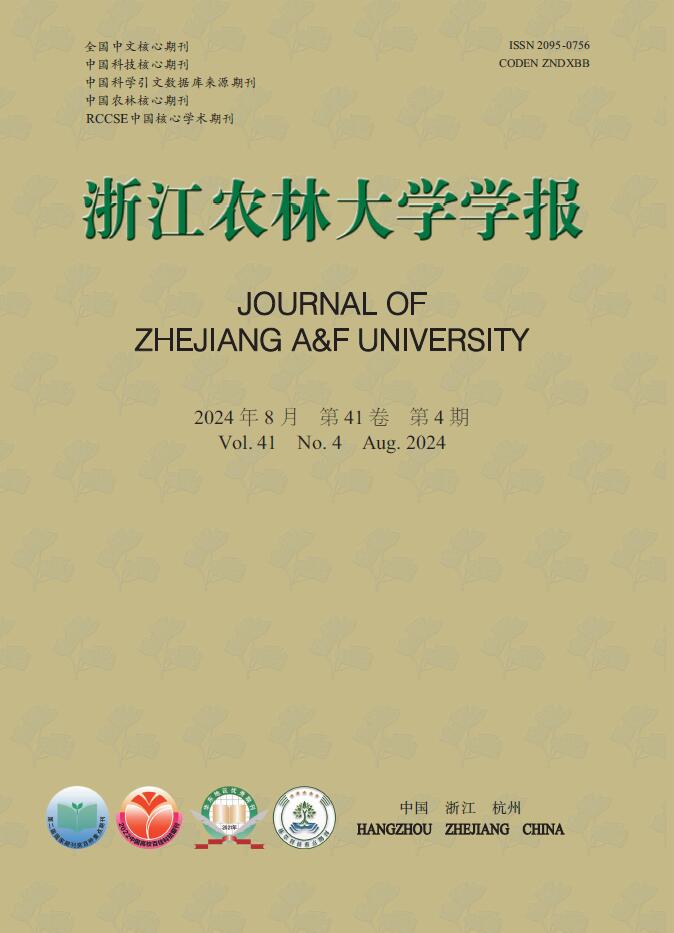-
木材不仅具有广泛的经济价值,而且对人类生产生活也具有重要意义[1−2]。木本植物经历初生生长和次生生长2个发育阶段,初生生长是由茎尖干细胞(SAM)和根尖干细胞(RAM)分裂分化引起器官伸长的生长,次生生长是由维管形成层和木栓形成层细胞分裂分化促进器官加粗的生长[3]。由于维管形成层不断分裂和分化,树木才会逐年加粗[4]。木材是维管形成层细胞的增殖分化产生的次生木质部不断沉积、累加的结果。以上研究表明:以杨树Populus为主的木本植物形成层发育过程受到很多信号调控,例如一些植物激素、肽受体蛋白和转录因子等。本文围绕以上几个方面展开综述。
-
维管系统的出现是植物从水生到陆生长期适应环境的结果。维管系统分为木质部、韧皮部和原形成层3个组成部分[5−7]。木质部和韧皮部来源于原形成层,原形成层产生初生韧皮部和初生木质部,初生韧皮部和初生木质部共同组成初生维管束[8−9]。维管形成层属于次生分生组织,由初生分生组织、根和茎的顶端分生组织分化而来。根维管形成层起源于原形成层细胞及周围的薄壁组织分化,其中部分细胞通过平周分裂产生形成层[10−11]。茎中的维管形成层可以分为束中形成层和束间形成层,束中形成层和束间形成层形成一个完整的环,这个环也称为维管形成层[12]。
维管形成层活动产生次生韧皮部和次生木质部[13],次生韧皮部和次生木质部的形成过程便是植物的次生生长。随着初生生长结束,木本植物便开始次生生长。维管形成层活动驱动次生生长进程[12]。木材是由次生木质部细胞凋亡、次生壁加厚所形成的树干部分,是木本植物次生生长发育的产物[5, 14]。木材形成的主要细胞来源是维管形成层干细胞,木材形成过程涉及形成层细胞增殖、木质部细胞伸长和增大、次生细胞壁沉积、程序性细胞死亡以及心材形成几个连续的步骤[15]。形成层活性对木材形成至关重要。
-
维管形成层细胞是一种双面干细胞,也称为多能干细胞,具有形成韧皮部和木质部细胞类型的能力[16−17]。维管形成层干细胞经过分裂分化产生次生韧皮部和次生木质部[18]。维管形成层干细胞来源于纺锤状原始细胞和射线原始细胞,其中纺锤状原始细胞向内分化形成次生木质部,向外分化形成次生韧皮部,韧皮射线由射线原始细胞分裂产生的薄壁细胞组成,维管射线形成输导系统[19−20]。
近年来,维管形成层增殖分化的分子调控机制成为生物学和林学领域的热点,维管形成层生长发育的分子机理也取得较大进展。关于维管形成层干细胞是由一层还是多层干细胞组成的问题,近期有学者通过解剖学和空间转录组学测序等方法进行研究,认为多年生木本植物的韧皮部和木质部的产生可能依赖于2个独立的分生组织池,即可能存在2个干细胞活性中心:韧皮部中的干细胞群和维管形成层区域的干细胞群,分别形成韧皮部和木质部细胞[21]。在形成层生长发育过程中,一些植物激素、小肽和相关转录因子协同发挥作用,严密调控维管形成层的活动[2]。
-
维管形成层的活性受到几种激素的调节,包括生长素(IAA)、细胞分裂素(CK)、乙烯(ET)、油菜素内脂(BR)、赤霉素(GA)等[22]。它们相互协调可以促进形成层增殖和木材发育。
许多证据表明:生长素的峰值累积主要出现在杨树形成层干细胞,生长素的极性流动与它的输出转运体PIN1蛋白相关,说明PIN1基因上调表达促进了形成层活性和次生生长[23]。BJÖRKLUND等[24]和AGUSTI等[25]研究证明:在去顶的杨树中外施生长素能正向调控形成层干细胞活性,促进形成层细胞的分裂分化。在红松Pinus koraiensis中,生长素积累诱导形成层细胞分化[26],生长素浓度升高促进木质部细胞数量增加[27]。NILSSON等[23]通过降低生长素响应性,扰乱了生长素信号传导,表明降低生长素水平会降低形成层细胞的分裂活性。生长素诱导的MP/ARF5抑制WOX4基因活性,并限制干细胞的数量[28]。QIU等[29]发现在杉木Cunninghamia lanceolata的形成层中,生长素响应因子ARF上调,表明ARF基因参与形成层和木材形成的调控。有研究发现:过表达IAA9抑制杨树次生生长,表现为形成层变窄,木质部层数大幅度减少,转录因子ARF5能与杨树中的IAA9蛋白互作,过表达IAA9抑制次生木质部发育,但IAA9-ARF5介导的生长素信号转导可以恢复过表达IAA9导致的木材形成和形成层活性受抑制的表型。由此可见:IAA9-ARF5模块可以调控木材发育[30]。研究发现:HD-ZIP Ⅲ基因家族中的HB7、HB8在过表达IAA9株系中受到明显抑制,IAA9-ARF5模块共同调控HB7、HB8对生长素的响应,促进木质部分化[30],还发现ARF7通过下游的WOX4提高形成层干细胞活性,促进形成层向次生木质部的分化[10]。
赤霉素峰值累积主要出现在木质部,内源赤霉素正向调控杨树形成层活性。MÄKILÄ等[31]报道:赤霉素通过诱导PIN1的表达,诱导形成层增殖。在红松中施加外源赤霉素促进形成层增殖,过表达赤霉素氧化酶GA20OXⅠ能促进木质部细胞分化及伸长,还能改善木质部纤维长度[32−34]。赤霉素对木材分化和次生木质部成熟的影响有待进一步探讨。细胞分裂素峰值累积主要出现在幼嫩的次生韧皮部。研究认为:细胞分裂素以一种非细胞自主依赖性的方式来正向调控形成层活性,通过激活CLE41/44基因,促进导管分化抑制因子TDIF在次生韧皮部的累积,移动到形成层干细胞位置维持形成层干细胞活性[35]。转录因子TMO5和LHW同系物在杨树的形成层区表达[36],TMO5-LHW复合物通过调控细胞分裂素生物合成基因LOG3和LOG4,促进原形成层周壁细胞分裂[37]。过表达IPT7通过升高细胞分裂素水平,刺激杨树形成层细胞分裂和增加生物量。然而,NIEMINEN等[38]通过研究毛白杨Populus tomentosa形成层细胞分裂素信号传导对树干生长的影响,揭示了细胞分裂素水平降低会导致形成层生长受损。
以上3种激素信号在木材发育相关组织中存在着特异的分布模式。此外,乙烯、油菜素内酯也能促进树木维管形成层的分裂和次生生长,乙烯是杨树形成层分生组织中细胞分裂的内源调节因子。乙烯信号传导与PXY/CLE41信号传导一样,乙烯水平升高促进形成层的发育[39−40]。油菜素内脂合成被抑制导致次生木质部分化减少,当油菜素内酯水平升高时会促进杨树次生生长和木材形成[41]。JIN等[42]发现:通过激活油菜素内脂信号传导,PtiCYP85A3正向调控杨树中木材凝胶纤维发育。近年来研究结果证明:内源赤霉素正向调控杨树形成层活性在很大程度上依赖于生长素信号转导,即生长素和赤霉素协同调控维管系统的发育过程[19]。由此可以看出:不同激素之间的相互作用形成了对形成层的复杂调控,因此,还需要更加深入地剖析形成层活动的激素调控。表1总结了参与调控木本植物维管形成层活动的植物激素及其表达部位。
Table 1. Plant hormones involved in regulating the activity of the vascular cambium of woody plants
-
肽受体通过与质膜上的受体激酶相互作用,控制植物的发育和生理过程,如植物维管形成层干细胞增殖分化[43]。其中WOX基因家族成员WOX4作为形成层活性的调控枢纽,调控形成层活性,WOX4蛋白正向调控杨树形成层细胞的增殖分化[44]。WOX14与WOX4协同作用于形成层细胞增殖[45]。WOX4和WOX14已被证明是TDIF/CLE41/44信号通路的下游靶点,正向调控形成层活性[44, 46]。在杨树中,对WOX4基因进行RNAi干涉,抑制转基因植株次生生长,结果表明:WOX4基因正向调控树木维管形成层活性[44, 47]。BUSH等[48]通过实验揭示了控制形成层维持的肽-受体-转录因子信号通路TDIF/CLE41/ CLE44-TDR/PXY,该信号通路正向调控WOX4和WOX14的表达,促进形成层活性提高[49]。KNOX基因家族KNAX I/BP影响形成层细胞分裂,过表达KNAX I/BP的同源基因ARK2,抑制杨树木材形成[50]。DU等[50]报道了ARK2负调控木质部分化的同时,也刺激形成层细胞分裂,表明ARK2与WOX4协同调控形成层活性。
三角状五肽重复蛋白(PPR)是线粒体编码基因RNA代谢的关键调控因子,PPR14编码RFL蛋白,并在杨树茎中高表达,其中RFL30过表达抑制生长素积累,形成层细胞和木质部细胞层数显著减少[51]。同时,通过生化实验发现:杨树ARF7蛋白通过直接结合WOX4和PIN1基因的启动子,整合赤霉素信号和生长素信号调控杨树维管形成层活性,促进生长素累积和形成层活性提高[52]。DELLA蛋白为赤霉素信号转导的阻遏子,可以发现它与ARK2、WOX4、赤霉素受体GID1发生互作,抑制杨树形成层分裂活性,赤霉素水平上升后,DELLA蛋白降解,促进ARK2与WOX4的表达,增强形成层的活性[3, 52]。
在转基因杨树中,TANG 等[53]鉴定到1个泛素化受体DA1,表明DA1负调控形成层活性,且酵母双杂筛选结果验证了DA1与WOX4拮抗作用于调控形成层活性,DA2介导的泛素化途径调控WOX4蛋白的稳定性,调控DA1-WOX4蛋白复合体以抑制形成层活性,揭示了转录水平上调控杨树形成层发育的新途径,可作为木材生物量改良的潜在方向。
短肽信号分子 CLE20蛋白在白杨 Populus alba木质部组织中表达并抑制形成层活性和细胞分裂相关基因表达,导致细胞层数减少[54]。在NAC结构域蛋白基因家族中,白杨VND和NST1/3参与木质部分化[55−57]。表2总结了参与调控木本植物维管形成层活动的多肽及其功能。
Table 2. Peptides involved in regulating the activities of the vascular cambium of woody plants
在杨树中发现了1种类受体蛋白激酶ASX,敲除后会导致木质部细胞中次生细胞壁的增厚,抑制形成层细胞向木质部细胞分化,SERK2/4通过催化ASX磷酸化,促进树木的木材形成[58]。细胞分裂素受体基因组氨酸激酶PtHK3a/3b在分裂的杨树形成层细胞中以高水平表达[38]。综上可以得出:PtHK3a/3b能够促进形成层细胞分裂分化,而ASX负调控形成层活性。以后需要加强这些受体激酶在维管形成层活动过程中功能差异的研究。在杨树中,HD-ZIP Ⅲ/HB基因家族中的HB4过表达能增强形成层活性和诱导束间形成层形成,HB4负调控PIN1表达,抑制了束间形成层发育[59]。此外发现HB5和HB7诱导形成层活性和木质部分化[60−61]。研究发现了2个来自杨树的MADS-box转录因子VCM1和VCM2,抑制维管形成层增殖活性和木材形成,且VCM1基因负调控PIN5表达,VCM 1和 VCM 2能抑制维管形成层增殖活性和次生生长[62]。研究鉴定出95个在维管形成层特异表达的转录因子VCS,其中VCS2负调控WOX4表达,表明VCS2负调控维管形成层增殖[63]。生长素响应因子ARF5与VCS2一样,抑制形成层活性[10, 44]。杨树中转录因子ANT在形成层中表达,细胞分裂素调控ANT和细胞周期蛋白CYCD3;1,通过形成层细胞的增殖实现根茎增粗[64]。MYB转录因子参与调控植物的发育和代谢,调节次生细胞壁的形成[65]。在柳杉Cryptomeria fortunei中,MYB转录因子和miRNA差异表达显著减少,使形成层细胞提前结束休眠。过表达MYB6显著抑制杨树次生木质部细胞壁的沉积[66−67]。表3总结了参与调控木本植物维管形成层活动的转录因子及其靶基因。
Table 3. Transcription factors involved in the regulation of vascular cambium activities in woody plants
-
木本植物维管形成层活动对植物的生长发育起着至关重要的作用。本文从分子层面对影响树木形成层活动相关因子研究进行综述。近年来,维管形成层持续受到研究者高度重视,关于木本植物维管形成层的分子调控取得了较大进展,由最初的单一调控途径到现在各种激素、基因、信号肽、转录因子等交叉发挥作用的网络途径。但是,关于维管形成层增殖分化的调控过程的研究还不够深入,未来应加强对各种网络途径之间相互作用与调节的研究,例如SERK2/4与IPT7、ARK2与PtHK3a/3b之间的调控关系。WOX4、WOX14、HB4、HB7 、HB8、ANT正向调控树木形成层活动,可作为木材增粗育种转基因的首选。此外,树木的形成层活动还受到环境因子和生物因子的共同影响,但目前响应机制尚不清楚,因此未来的研究必须考虑环境因子和生物因子等的影响,在分子层面进一步研究影响因子的调控作用。
目前,对木本植物维管形成层调控机理的认识较有限。深度成像结合基因表达分析技术有助于表征形成层细胞的起始和发育,数学建模和仿真结合实时成像在模拟形成层生长和潜在的分子过程中有重要应用前景,可用于构建形成层生长的调控框架,模拟树木形成层组织的定位与分配,揭示组织和细胞间的交流。已有研究通过计算机模型,实现了形成层活动的可视化,破除了活细胞难以成像的弊端,利用计算机模型整合形成层调节因子的功能,剖析形成层内细胞间通信的联系[68]。这一最新研究技术的出现可能会有助于全面解析木本植物维管形成层发育分子机制,应致力于将其应用于未来林木分子育种,实现林木材性定向改良。
Molecular regulatory mechanisms of cambium activity in woody plants
doi: 10.11833/j.issn.2095-0756.20230473
- Received Date: 2023-09-15
- Accepted Date: 2024-01-05
- Rev Recd Date: 2023-12-27
- Available Online: 2024-07-12
- Publish Date: 2024-07-12
-
Key words:
- vascular cambium /
- hormone /
- peptide receptor signaling /
- transcription factors /
- woody plant /
- review
Abstract: The vascular cambium is located between the xylem and phloem, which is responsible for many growth and development processes, and also plays an important role in wood production. In simulating cambium growth and potential molecular processes, deep imaging combined with gene expression analysis is a cutting-edge research direction, and mathematical modeling and simulation combined with real-time imaging have important application prospects. Based on this technique, some representative achievements at the molecular level of cambium activity are summarized, and the future research prospects are proposed. At present, molecular studies on cambium activity in plants mainly focus on: (1) cambium activity is regulated by plant hormone signaling; (2) cambium activity is regulated by transcription factors and peptide receptor signaling; (3) cambium activity is regulated by receptor kinase signals peptide receptor signaling. The main conclusions are that WOX4, WOX14, HB4, HB7, HB8 and ANT positively regulate the activities of tree cambium and can be used as the first choice for transgenic wood roughening breeding. In the future, the analysis of cell-to-cell communication connections in the cambium through computer models can better analyze the molecular mechanism of vascular cambium development in woody plants. [Ch, 3 tab. 68 ref.]
| Citation: | YE Qingqing, ZHOU Mingbing. Molecular regulatory mechanisms of cambium activity in woody plants[J]. Journal of Zhejiang A&F University, 2024, 41(4): 879-886. DOI: 10.11833/j.issn.2095-0756.20230473 |









 DownLoad:
DownLoad: